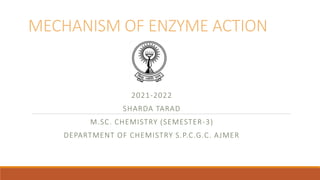Mechanism of enzyme action
•Als PPTX, PDF herunterladen•
1 gefällt mir•1,430 views
Sharda Tarad semester 3
Melden
Teilen
Melden
Teilen

Empfohlen
Empfohlen
Weitere ähnliche Inhalte
Was ist angesagt?
Was ist angesagt? (20)
Regulatory and allosteric enzymes and allostrerism

Regulatory and allosteric enzymes and allostrerism
Enzymes properties, nomenclature and classification

Enzymes properties, nomenclature and classification
Covalent and non Covalent interaction in Macromolecules

Covalent and non Covalent interaction in Macromolecules
Derivations of ENZYME KINETICS (Part 1 - simplified and detailed)

Derivations of ENZYME KINETICS (Part 1 - simplified and detailed)
Ähnlich wie Mechanism of enzyme action
Ähnlich wie Mechanism of enzyme action (20)
CELL MEMBRANE , RECEPTOR , DRUG RECEPTOR INTERACTION

CELL MEMBRANE , RECEPTOR , DRUG RECEPTOR INTERACTION
Experimental Study in Optimizing Enzyme-based Polymeric Membrane Bioreactors

Experimental Study in Optimizing Enzyme-based Polymeric Membrane Bioreactors
Mehr von SPCGC AJMER
Mehr von SPCGC AJMER (20)
Kürzlich hochgeladen
Kürzlich hochgeladen (20)
Biogenic Sulfur Gases as Biosignatures on Temperate Sub-Neptune Waterworlds

Biogenic Sulfur Gases as Biosignatures on Temperate Sub-Neptune Waterworlds
Seismic Method Estimate velocity from seismic data.pptx

Seismic Method Estimate velocity from seismic data.pptx
PossibleEoarcheanRecordsoftheGeomagneticFieldPreservedintheIsuaSupracrustalBe...

PossibleEoarcheanRecordsoftheGeomagneticFieldPreservedintheIsuaSupracrustalBe...
Botany krishna series 2nd semester Only Mcq type questions

Botany krishna series 2nd semester Only Mcq type questions
❤Jammu Kashmir Call Girls 8617697112 Personal Whatsapp Number 💦✅.

❤Jammu Kashmir Call Girls 8617697112 Personal Whatsapp Number 💦✅.
Labelling Requirements and Label Claims for Dietary Supplements and Recommend...

Labelling Requirements and Label Claims for Dietary Supplements and Recommend...
Vip profile Call Girls In Lonavala 9748763073 For Genuine Sex Service At Just...

Vip profile Call Girls In Lonavala 9748763073 For Genuine Sex Service At Just...
TEST BANK For Radiologic Science for Technologists, 12th Edition by Stewart C...

TEST BANK For Radiologic Science for Technologists, 12th Edition by Stewart C...
Pulmonary drug delivery system M.pharm -2nd sem P'ceutics

Pulmonary drug delivery system M.pharm -2nd sem P'ceutics
Formation of low mass protostars and their circumstellar disks

Formation of low mass protostars and their circumstellar disks
GUIDELINES ON SIMILAR BIOLOGICS Regulatory Requirements for Marketing Authori...

GUIDELINES ON SIMILAR BIOLOGICS Regulatory Requirements for Marketing Authori...
High Class Escorts in Hyderabad ₹7.5k Pick Up & Drop With Cash Payment 969456...

High Class Escorts in Hyderabad ₹7.5k Pick Up & Drop With Cash Payment 969456...
Mechanism of enzyme action
- 1. MECHANISM OF ENZYME ACTION 2021-2022 SHARDA TARAD M.SC. CHEMISTRY (SEMESTER-3) DEPARTMENT OF CHEMISTRY S.P.C.G.C. AJMER
- 2. CONTENT 1. INTRODUCTION OF ENZYMES 2. TRANSITION-STATE THEORY 3. COVALENT CATALYSIS 4. ACID BASE CATALYSIS 5. INTRAMOLECULAR CATALYSIS 6. EXAMPLE OF CHYMOTRYPSIN ENZYME
- 3. INTRODUCTION OF ENZYMES • Biological catalysts • Neither consumed nor permanently altered • All enzymes are proteins in nature except ribozymes which are RNA in nature • Highly efficient • Act as selective catalysts • Site where actual Reaction occurs • Substrate-bound by weak interaction
- 4. MECHANISM OF ENZYME ACTION The catalystic efficiency of enzyme is explained by 2 perspectives: 1.Thermodynamic change 2.Processes at the active site
- 5. • What is transition-state theory? • All chemical reaction have eneygy bariers between reactant and products. • Activational Barrier:- Differnce in energy level of Transitional state and Substrate. SUBSTRATE PRODUCTS
- 6. • Activation Energy:- of a chemical reaction is the minimum energy that is needed to make the reaction happen. • Only a few Substrate can cross this barrier to be converted to Products. • That is why rate of uncatalyzed reaction is much slow. • When enzyme is present it provide an alternate pathway for conversion of Substrate into product. • Enzymes accelerate reaction rate by providing Transtion state with low activational energy for formation of products. • The total energy of the system remains the same equilibrium state is not disturbed
- 8. PROCESS AT THE ACTIVE SITE
- 9. • Enzyme from covalent linkages with substrate forming transient enz-subs complex with very low activational barrier. • Enzyme is then released unchanged and unconsumed and substrate is converted into products.
- 10. ACID BASE CATALYSIS • Mostly undertaken by oxido-reductases. • Mostly at the active site, either histidine is present which act both as a proton donor and a proton acceptor.
- 11. INTRAMOLECULAR CATALYSIS • This mechanism is mostly undertaken by ligases. • The rate of reaction is by bringing substrate closer to each other at the a.site. • A region of high substrate conc. is produced at the active site.. • The substrates molecule is placed at bond forming distances. • Since substrate is placed at optimal distances. • The probability of collision and substrate is eventually converted into products. (ORIENTATION AND STERIC EFFECT)
- 12. Structure of Chymotrypsin Globular single-domain protein. Originally synthesized as a 245 residue protein, chymotrypsinogen. Dipeptides 14-15 and 147-148 are clipped out, transforming the protein into active chymotrypsin. Therefore it has 3 chains (red, blue, green) but these are covalently linked by disulfide bridges. The reactive serine 195 is located in a cleft on the molecule, the active site. Ser195 is adjacent to His57 and Asp102 which are responsible for its reactivity.
- 13. CHYMOTRYPSIN • Serine protease • Catalystic mechanism involves Ser residue. • Utilizes catalytic triad • Asp102-His57-Ser195 • Ser provides nucleophile(o atom) • His acts as base catalyst to activate Ser • Asp stabilizes protonated His • 2-step reaction covalent catalysis
- 14. MECHANISM OF CHYMOTRYPSIN STEP 1: H+ Shift generates Ser-O¯(substrate binding) STEP 2: Ser-O¯binds to C꓿O(Nucleophilic attack) STEP 3: Transition state ׀ STEP 4: Peptide bond breaks
- 15. MECHANISM OF CHYMOTRYPSIN STEP 5: C-Terminal Peptide leaves STEP 6: Ionization of water STEP 7: Transition State װ STEP 8: N-Terminal peptide leaves
- 16. REFERENCES : - • Harper’sIllustrated Biochemistry • Bio-OrganicChemistryby Dr.VinayPrabhaSharma